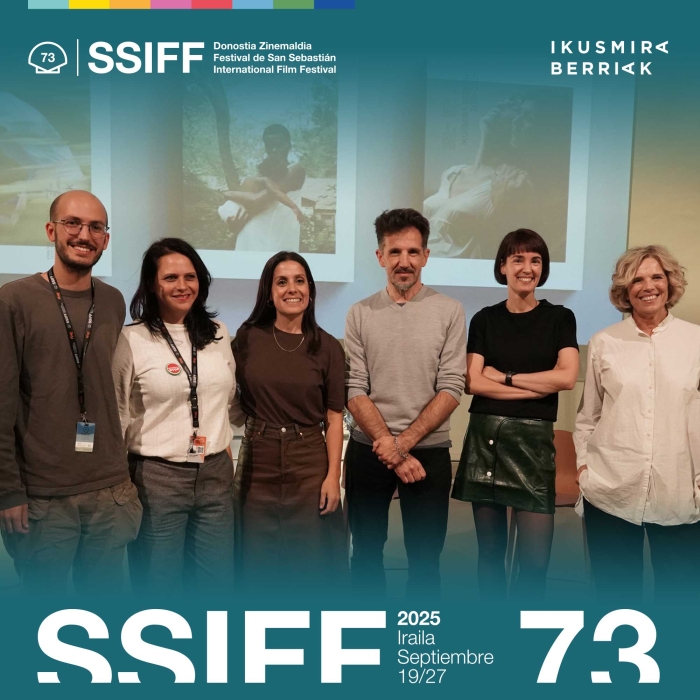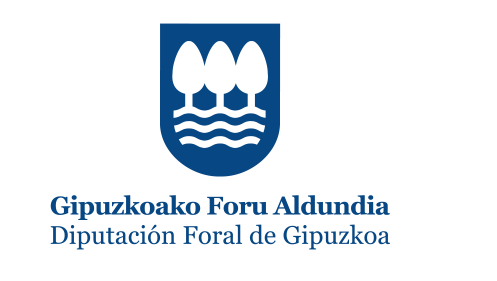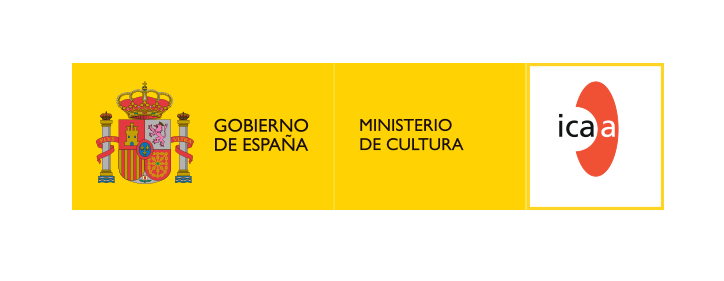The publication, Ikusmira Berriak 2015-2025, which casts its eyes back over a decade of providing support to up-and-coming talent and audiovisual creation by the residencies programme backed by the San Sebastián Festival, Tabakalera and the Elías Querejeta Zine Eskola, had its launch today in the framework of the Festival and of Kabia, the event dedicated to emerging cinematic talent. This commemorative work includes texts by guest writers and the institutions who have enabled the programme, in addition to interviews with filmmakers representative of Ikusmira Berriak’s ten editions. Not only does the book celebrate a decade of support, but it also serves as a testimony to the impact of the films to have passed through the programme while turning the spotlight on a shared journey, impossible to understand without the filmmakers who have played a part in its history.
The book opens with articles on behalf of the three institutions supporting the residency: Maialen Beloki Berasategui, Deputy Director of the San Sebastián Festival; Carlos Mugiro, Academic Director of the Elías Querejeta Zine Eskola, Clara Montero Tellechea, Cultural Director of Tabakalera; and Sara Hernández Askasibar, Coordinator of the Audiovisual Programme at the international centre for contemporary culture. As explained by Maialen Beloki Berasategui, “on its 10th anniversary, it’s time to take stock”. In terms of numbers, more than 1,800 proposals have been submitted. Support has been provided to 56 audiovisual projects, of which 28, now completed, have been selected for a widespread international circuit of festivals, where they have received, amongst others, the following recognitions: a Best European Film Award at the Quinzaine in Cannes, a Special Jury Prize from the Orizzonti section at the Venice Biennale, a FIPRESCI Prize in the Berlinale’s Encounters section, a Best Film Award at DocLisboa, a Best Film Award at Punto de Vista, a Best Technical Contribution Award at the Venice Critics’ week, one Goya, six Gaudis, one Irizar Basque Film Award, two special mentions in Zabaltegi-Tabakalera and one Golden Shell at the San Sebastián Festival.
As far as conclusions on quality are concerned, it is safe to say, on the one hand, that this circuit of programmed films and the awards they have harvested show how Ikusmira Berriak has become a label observed attentively by players in the sector, from production companies to festivals. On the other, the residency has served to take a step forward and portray an new generation of arrivals in Basque cinema, largely made up of women filmmakers (Maider Oleaga, Amaia Merino, Maider Fernández Iriarte, Arantza Santesteban, Aitziber Olaskoaga, Jaione Camborda, Marina Palacio, Irati Gorostidi, Maddi Barber, Mikele Landa, Maria Elorza and Joana Moya).
The director of the EQZE quotes George Steiner as the ideal ethos of a school: “This would be a school where the student has permission to make that big mistake which is hope”. Muguiro ended by saying that, “indeed, there is no greater exercise of hope than to imagine a film that has still not been made. Whether or not you call it a school (post-school, ideal school, transmuted school), that place is Ikusmira Berriak”. From Tabakalera, Clara Montero and Sara Hernández recall that “the accompaniment is not limited to the time spent at the residency” but that Ikusmira Berriak “is instead an ongoing relationship which enables the residency to develop flawlessly and paves the way for the transition from time-specific creation to the building of a career in the audiovisual industry”.
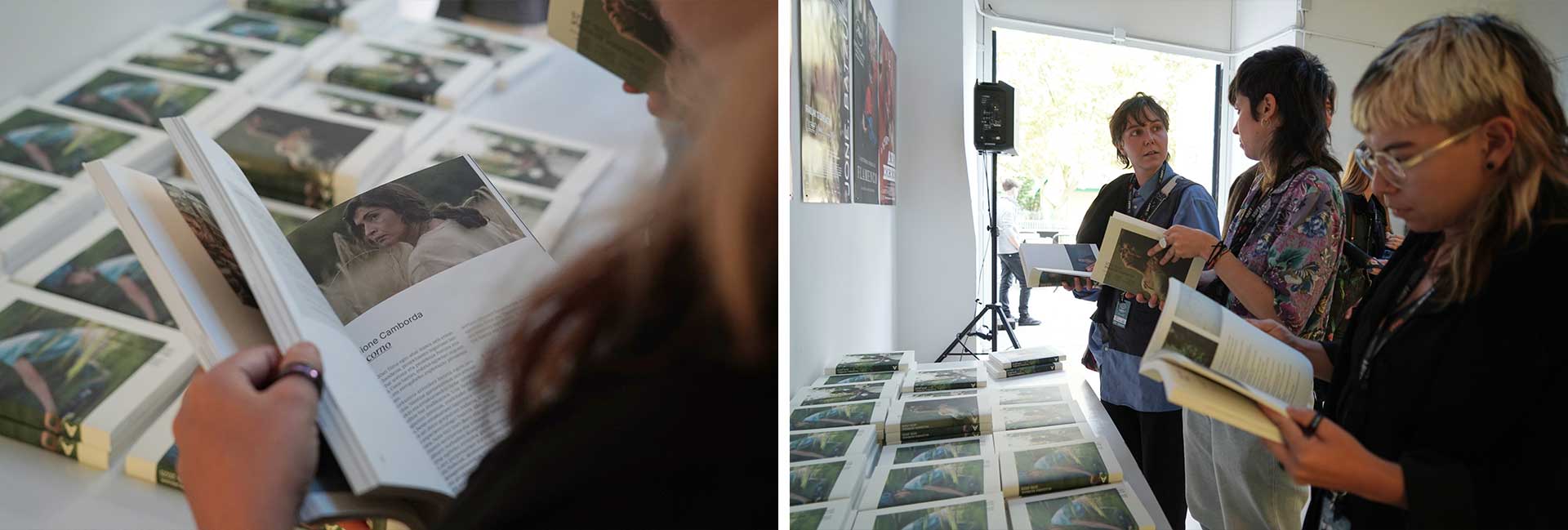
Also appearing in the book are contributions from film industry professionals: the filmmaker Albertina Carri, the producer Eugenia Mumenthaler and the programmer Carlo Chatrian, former director of the Berlin and Locarno festivals and current head of the Turin Museum of Cinema, who have either been members of the pre-selection committee or have served as tutors, and Víctor Iriarte, who participated in founding the programme, was a member of its selection committee for several editions and has accompanied and given workshops to its filmmakers. Carri defines her experience at Ikusmira Berriak thus: “Accompanying new filmmakers in the odyssey towards finding their own voice is an essential alteration in a consumer system which is increasingly more alienating and encrypted”. Mumenthaler shares this sentiment: the programme offers “the opportunity to visit new stories, where society can feel represented in its entirety and questioned from the contemporary angle”. Chatrian vividly recalls his first impression: “Although the projects I examined were extraordinary, the most powerful feedback was that of a shared creative energy. To put it simply, I had the same contagious feeling I had when I started getting hooked on film festivals: the idea that, away from the chaos of the outside world, something is taking shape – here and now”. Iriarte extends an express invitation: “Filmmakers of the future, here you have a home and an alphabet. Make magic. Invent words and films. Own it. Make fire”.
The book brings together ten interviews with filmmakers from each edition, questions and answers making reference to the creative processes, key filmmakers and inspirational films, and to the memories tied to the residence: Xacio Baño (2015), Kiro Russo (2016), Helena Girón y Samuel M. Delgado (2017), Arantza Santesteban (2018), Raven Jackson (2019), Jaione Camborda (2020), Eduardo Crespo (2021), Meritxell Colell (2022), Naomi Pacifique (2023) and Mikele Landa (2024). “Filmmakers coming from different places – geographical, generational and emotional – who are driven by the same impulses of the why and wherefore of making films”, as expressed in the epilogue by the Head of Ikusmira Berriak, Maialen Franco Davila, who has coordinated the volume designed by Diego Zarrabeitia.
In addition to the texts, the volume contains all sorts of graphic material: as well as images of stills from the projects created, there are also parts of a storyboard, pages from a screenplay with hand-written jottings, photographs, notes, drawings and even fragments of a plant collection.
The book launch at the Tabakalera Cinema and Audiovisual Lab was attended by Jaume Claret Muxart (Ikusmira Berriak 2022), who is presenting in Zabaltegi-Tabakalera following its premiere at the Venice Festival (where it won the Bisato d’Oro for Best Artistic Contribution) Estrany Riu / Strange River, the project he developed at Ikusmira Berriak, and Jaione Camborda, who won the Golden Shell with the project developed at the residency in 2020: O Corno / The Rye Horn. The images on the front and back covers of the commemorative book precisely come from Estrany Riu and O Corno. The third image belongs to All Dirt Roads Taste of Salt (Ikusmira Berriak 2019), by the North American filmmaker Raven Jackson, premiered at Sundance and winner of RTVE Another Look Award special mention in San Sebastián.
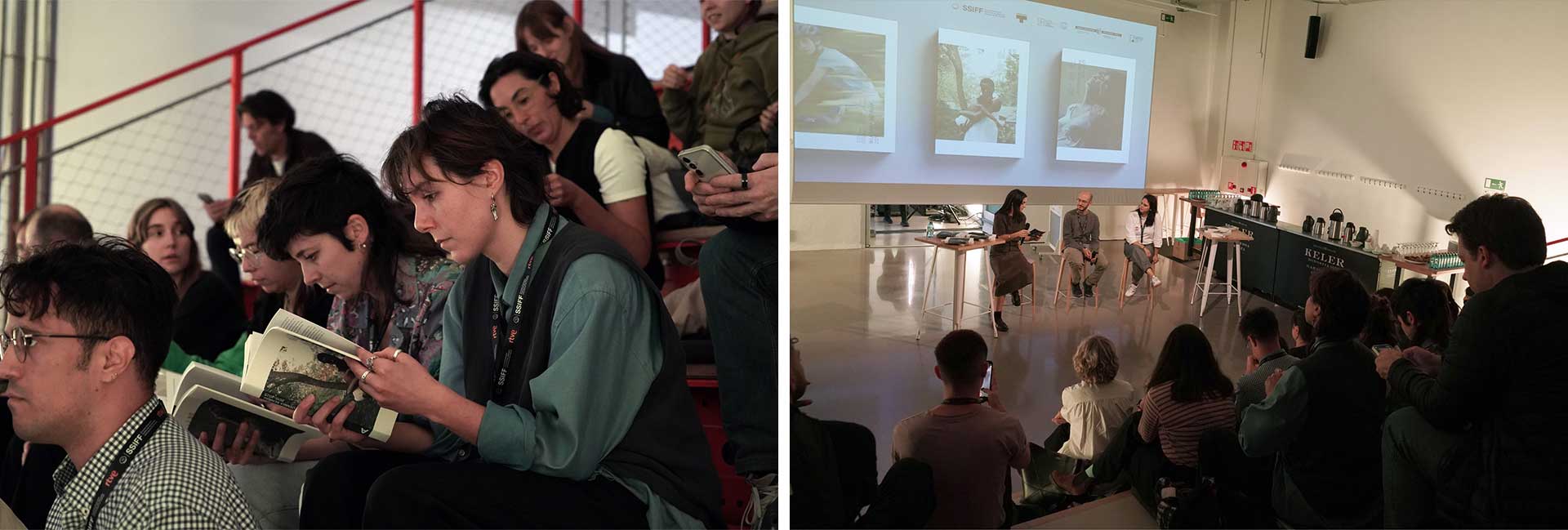
Participating filmmakers (59):
Pablo Álvarez, Tamyka Smith, Maider Oleaga, Xacio Baño, Kiro Russo, Leo Calice, Gerhard Treml, Aitor Merino, Amaia Merino, Mikel Gurrea, Julia Pesce, Leonardo van Dijl, Maider Fernández Iriarte, Samuel M. Delgado, Helena Girón, Arantza Santesteban, Grigory Kolomytsev, Nele Wohlatz, Elena López Riera, Manuel Abramovich, Raven Jackson, Alberto Martín Menacho, Aitziber Olaskoaga, Michael Wahrmann, Martina Juncadella, Gabriel Azorín, Elena Martín Gimeno, Diego Céspedes, Jessica Sarah Rinland, Jaione Camborda, Magdalena Orellana, Eduardo Crespo, Manuel Muñoz Rivas, Mina Kim Fitzpatrick, Marina Palacio Burgueño, Irati Gorostidi Agirretxe, Jaume Claret Muxart, Maximiliano Schonfeld, Ana Cristina Barragán, João Paulo Miranda Maria, Meritxell Colell Aparicio, Naomi Pacifique, Maddi Barber, Sameh Alaa, David Pérez Sañudo, María Alché, Hikaru Uwagawa, Marieke Elzerman, Lucy Kerr, Maria Elorza, Mikele Landa, Cande Lázaro, Felipe Gálvez, Alexandra Latishev, Kathy Mitrani, Jaime Puertas, Fede Gianni, Daniel Soares and Joana Moya.
